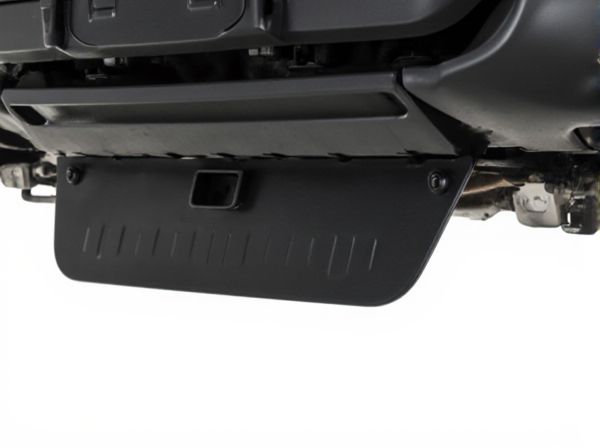
Photo illustration: Integrated skid plate vs Separate skid plate
An integrated skid plate offers seamless protection by being built directly into the vehicle's structure, enhancing durability and reducing the risk of debris entering vulnerable areas. A separate skid plate provides flexibility and ease of replacement, allowing you to upgrade or customize your protection based on terrain challenges. Choosing between the two depends on your specific off-road demands, balancing long-term reliability with practical maintenance.
Table of Comparison
| Feature | Integrated Skid Plate | Separate Skid Plate |
|---|---|---|
| Design | Built into the bumper structure | Attached separately to the bumper |
| Durability | Less prone to detachment, moderate impact resistance | Higher impact absorption, easier to replace after damage |
| Cost | Generally lower, fewer parts | Higher initial cost due to additional components |
| Maintenance | Challenging to repair; requires bumper replacement | Easy to maintain and replace independently |
| Weight | Typically lighter as part of bumper | Often heavier due to added components |
| Protection | Basic undercarriage protection | Enhanced protection for off-road and rough terrain |
| Installation | Factory installed, permanent | Can be aftermarket installed or upgraded |
Introduction to Skid Plates
Skid plates protect a vehicle's undercarriage from damage caused by rough terrain, rocks, and debris. Integrated skid plates are built into the vehicle's frame during manufacturing, offering seamless protection and structural reinforcement. Separate skid plates are aftermarket additions, providing customizable and easily replaceable protection depending on the vehicle's use and terrain challenges.
What Is an Integrated Skid Plate?
An integrated skid plate is a protective component built directly into the vehicle's chassis or underbody design, providing seamless defense against rocks, debris, and rough terrain. Unlike separate skid plates, which are aftermarket additions bolted onto the underside, integrated skid plates offer enhanced durability and better alignment with vehicle contours. This integration reduces the risk of loosening or damage during off-road driving, improving overall vehicle safety and performance.
What Is a Separate Skid Plate?
A separate skid plate is a standalone protective component installed underneath a vehicle to shield critical parts such as the oil pan, transmission, and transfer case from off-road damage. Unlike an integrated skid plate, which is built into the vehicle's frame or bumper, a separate skid plate can be customized, replaced, or upgraded independently, offering flexibility for off-road enthusiasts. Its installation typically involves mounting brackets and bolts, allowing easy maintenance and enhanced protection tailored to specific driving conditions.
Key Differences Between Integrated and Separate Skid Plates
Integrated skid plates are built directly into the vehicle's underbody design, offering seamless protection with reduced weight and improved aerodynamics. Separate skid plates are aftermarket or add-on components, designed for specific areas, providing customizable and often more robust protection but potentially increasing weight and installation complexity. Vehicle manufacturers prefer integrated skid plates for streamlined performance, while off-road enthusiasts often choose separate skid plates for enhanced durability and ease of replacement.
Material and Durability Comparison
Integrated skid plates typically use high-strength steel or aluminum alloys, offering superior durability and impact resistance by forming a continuous protective barrier with the vehicle's frame. Separate skid plates are often made from less rigid materials such as plastic composites or thinner metals, which provide moderate protection but may be more prone to deformation or damage under severe off-road conditions. The seamless construction of integrated skid plates enhances longevity and structural integrity, while separate skid plates might require more frequent replacement due to their segmented design and material limitations.
Installation Process: Integrated vs Separate
Integrated skid plates simplify the installation process by being pre-attached to the vehicle's frame or chassis, eliminating the need for additional mounting hardware and reducing labor time. Separate skid plates require precise alignment and secure fastening with bolts or brackets, often involving more tools and a longer installation duration. Vehicles with integrated skid plates benefit from a streamlined setup, while separate skid plates offer flexibility but demand careful installation to ensure proper protection and fitment.
Maintenance and Repair Considerations
Integrated skid plates offer streamlined maintenance since they are designed as part of the vehicle's underbody, reducing the risk of misalignment or loose fittings during reassembly. Separate skid plates allow easier individual removal and replacement, which can simplify repairs and lower costs if only the skid plate is damaged. However, separate units might require more frequent inspections to ensure secure attachment, impacting overall maintenance routines.
Performance and Off-Road Protection
Integrated skid plates offer enhanced structural rigidity by distributing impact forces across the vehicle's chassis, improving overall performance and durability during off-road conditions. Separate skid plates provide targeted protection to specific components but may introduce weak points at the mounting interfaces, potentially compromising off-road resilience. Optimizing skid plate design depends on balancing comprehensive underbody protection with ease of maintenance and vehicle weight considerations for peak off-road performance.
Cost Analysis: Which Is More Affordable?
Integrated skid plates generally offer lower overall costs due to reduced material usage and simplified installation processes, making them more affordable for manufacturers and buyers. Separate skid plates often incur higher expenses because of additional mounting hardware and labor required for installation. Long-term maintenance costs may also be lower with integrated designs, as they minimize the risk of component misalignment and damage.
Choosing the Right Skid Plate for Your Vehicle
Choosing the right skid plate involves evaluating integrated skid plates, which offer seamless protection designed specifically for your vehicle model, against separate skid plates that provide customizable and often heavier-duty coverage for off-road conditions. Integrated skid plates benefit from precision fit and easier installation, while separate skid plates allow for flexibility in material choices such as steel or aluminum to match demanding terrains. Factoring in your vehicle's typical use, terrain challenges, and budget ensures optimal undercarriage defense and long-term durability.
 caratoz.com
caratoz.com